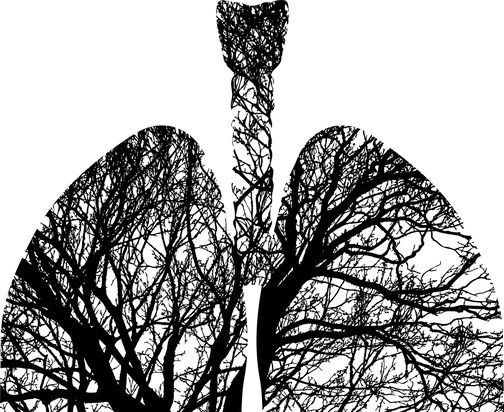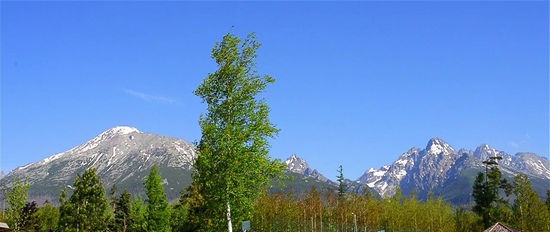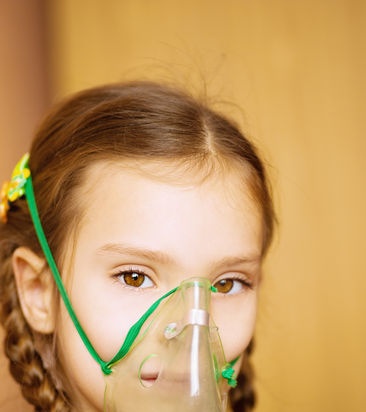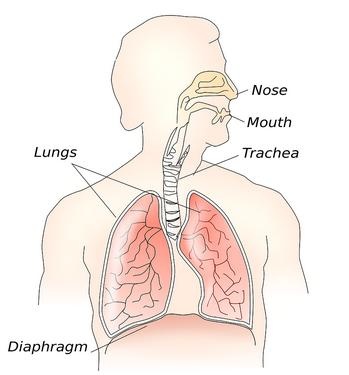About the air: clean, harmful and healing |
|
The breathing process itself is quite complex, and we will analyze it here only in general terms. The main essence of the life processes of the human body is the oxidation reaction of certain false organic substances. It is due to this that a person receives the energy that he needs to maintain the normal physiological state of the body. However, the processes of oxidation of organic substances require the presence of oxygen for their passage. In addition, carbon dioxide accumulated as a result of oxidative reactions is quite harmful and must be removed. It is these purposes that the breathing process primarily serves. Entering the lungs, air, or rather oxygen, enters the alveoli and from them passes through the thinnest tissue partitions, the thickness of which does not exceed several microns, into the blood. But, as you know, the solubility of gases (including oxygen) in the blood is low. So, for example, at a temperature of 37 ° C, only about 0.3 milliliters of oxygen dissolves in 100 milliliters of blood. However, under normal conditions, blood contains much more oxygen - up to 20 milliliters for every 100 milliliters. It turned out that the responsible for this "behavior" of blood is its dye - hemoglobin. Combining with oxygen, it turns into the so-called oxyhemoglobin, a substance that is already carried throughout the body by the blood stream. Under normal conditions, arterial blood in healthy people is almost completely saturated with oxygen. But oxyhemoglobin is a rather labile substance. Getting into the capillaries of the systemic circulation, it begins to give its oxygen to the tissues, turning back into hemoglobin. Along with this, the content of carbon dioxide begins to increase in the blood. Ultimately, the venous blood flowing to the lungs releases the accumulated carbon dioxide into them and is again enriched with oxygen. This is, in general terms, the process of breathing in humans. The rest of the gases contained in the air do not significantly affect this process. Indeed, if you remove all nitrogen from the air and replace it with some other inert gas (for example, helium or argon), in principle, such a replacement will not affect a person's well-being. But if we try to "take" a few percent of oxygen from the air, the picture changes dramatically. The person begins to suffocate, as they usually say, "does not have enough air." Indeed, a person can live without water for three to four days, but without air (more precisely, without oxygen) only for a few minutes.
It is interesting that numerous studies have shown that in this case, the body is largely accustomed to hypoxia, and this dramatically increases its overall stability and performance. For example, animals that underwent hypoxia were given various poisons (in particular, cyanides). As it turned out, these poisons are less terrible for these animals than for animals that have not been acclimatized to hypoxia. An organism that has undergone hypoxia more actively resists various infectious diseases, hypothermia, experimental heart attacks, etc. In addition, the health-improving and therapeutic value of multi-stage acclimatization in the prevention of diseases such as pneumonia, bronchial asthma, etc. has already been proven. This is primarily due to the fact that the nervous tissue (especially the cerebral cortex), the changes in which mainly determine the development of severe consequences of hypoxia, gradually "get used" to the lack of oxygen. It is assumed that the sensitivity of the internal nerve endings (interoreceptors) in tissues decreases "to the products of incomplete oxidation, which appear during hypoxia. Thus, we can say that the value (intensity) of impulses that are sent by nerve endings to the cerebral cortex decreases, and therefore the intensity of the return signal changes accordingly. But not only this limits the role of air, and especially oxygen in human life. As scientists have found (we have already spoken about this somewhat above), the Sun sends us its rays of the most diverse wavelengths. And some of them are extremely dangerous to human life, especially in large doses. This is the so-called ultraviolet, short-wave radiation.
But ozone plays not only the role of a "sieve", which weakens the rays of the Sun, which are harmful to living organisms, coming to the Earth. In addition, it performs the role of a kind of "fur coat" for our planet. The point is that ozone also has a maximum absorption in the infrared region of the spectrum, with a wavelength of about 10 microns. Namely, this wavelength corresponds to the thermal radiation of the Earth. Thus, the ozone in the atmosphere, as it were, delays thermal radiation and does not allow it to dissipate in space. Scientists have calculated that the cooling of the earth's surface would take place “much more intensively and our climate would be more severe if there was no kind of atmospheric ozone“ coat ". So we seem to have come to the conclusion that both oxygen and ozone “are essential for human existence. Indeed, we have already said that without oxygen, the life of humans and animals is simply impossible. In addition, ozone plays an important role in biochemical processes in the body. Remember how pleasant and light the air is after a thunderstorm! And how wonderful it smells! It turns out that ozone owes its smell to the post-pink air. At the earth's surface, ozone is formed mainly during lightning discharges and during the oxidation of certain organic substances. In connection with the latter circumstance, increased amounts of ozone are usually contained in the air of coniferous forests, where they are formed due to the oxidation of tree resin, as well as on the shores of the seas, where algae thrown by the surf on the coast are oxidized.Somewhat more of it than on the plains, in the mountainous regions, where it owes its origin to the ultraviolet radiation of the Sun. Such "ease" of ozonized air for breathing lies in the fact that the ozone molecules themselves are unstable and disintegrate with the formation of ordinary oxygen molecules and its atoms. And atomic oxygen reacts much lighter than ordinary oxygen. Including its connection with blood hemoglobin is much easier. Doctors have long noticed the beneficial effects of sea, mountain and forest air on the human body, especially in case of respiratory tract diseases. Along with other factors, this effect owes its origin to ozone. In this regard, as, of course, the reader knows, at present special devices have appeared in everyday life - ozonizers... After all, not every day a city person can afford to walk through the coniferous forest. And ozone, as it turned out, has not only a beneficial effect on the body, but also contributes to the destruction of various pathogenic microbes and microorganisms. So man has learned to create ozonized air at home.
And yet, although oxygen is the most important (in the sense of importance for humans) component of air, not only this characterizes its quality. Everyone knows, of course, how great a person's desire is to go out of town on a hot summer day, to breathe in the forest or on the river bank. In everyday speech we say: "I want to breathe clean air." Is ordinary air "dirty"? Yes, he is really dirty. And the higher we rise above sea level, the cleaner the air becomes. Here, for example, what data are available on the dustiness of the atmosphere: Height, km / The number of dust grains in 1 cm3 Translated into our ordinary language from the language of science, the air in Sukhumi is 1000 times "dirtier" than the air at the top of Elbrus. But it turns out that in different areas the air can differ not only in the content of acne or ozone (the oxygen content is practically constant throughout our planet). So, for example, along the banks of turbulent rivers, near waterfalls, the air contains negligible amounts of the so-called air ions. They are nitrogen and oxygen molecules, charged positively and negatively, respectively. In our country, at the beginning of the last century, the famous physicist A.P. Sokolov was one of the first to study air ions. It was his work that laid the foundations for the study of the biological action of atmospheric ions. It was A.P. Sokolov who first expressed the idea of two ways of action of air ions on humans - through the respiratory system and through the skin. Subsequently, A.P.Sokolov that there is an electrical exchange between the body and the air environment, which is carried out with the help of atmospheric ions, was confirmed and experimentally proven by both domestic and foreign scientists. The experiments of various researchers have shown that the concentration of light atmospheric ions in a number of resort areas is about 2000-3000 or more in 1 cubic centimeter of air, while the usual value is about 1000 air ions per 1 cubic centimeter. So, for example, in Pyatigorsk and Kislovodsk, the concentration of air ions ranges from 1500 to 3700 per 1 cubic centimeter, on the Caucasian coast of the Black Sea (Sochi) - 2300–2500, on the southern coast of Crimea - from 850 to 3360 per 1 cubic centimeter. It is interesting that in the resort area of Leningrad (near Sestroretsk) the concentration of air ions reaches 2900 per 1 cubic centimeter. Even larger quantities of air ions were found in the resorts of Central Asia - from 2500 to 7200 per 1 cubic centimeter. A particularly large number of them - up to 15,000-20,000 - is found on the banks of mountain rivers and near waterfalls.
The action of air ions can be explained as follows. First, settling in the pulmonary tract during breathing and turning into heavy hydroaeroions, they have a beneficial effect on the nervous activity of a person and, first of all, on the level of excitability of the respiratory tract. In addition, penetrating through the walls of the alveoli into the blood, they give up their charges to colloidal and cellular particles. Thus, inhalation of air ions to some extent increases the electrical charge of colloids and blood cells. Even a whole direction in the treatment of such diseases as, for example, bronchial asthma and hypertension is based on the use of air ions. In addition, air ions have a beneficial effect on mental fatigue and insomnia. In some cases, aerotherapy is useful for pulmonary tuberculosis. Naturally, a more detailed study of both the nature of air ions and the mechanism of their formation allows a more correct approach not only to the issues of their use for the treatment and prevention of a number of diseases, but also to a more correct, scientific approach to the choice of construction sites for new resorts, sanatoriums and rest homes.
In the atmospheric layers of the air, which are located at a sufficiently close distance from the earth's surface, along with the main constituents (nitrogen, oxygen), a number of other impurities can also be contained in sufficiently low concentrations. First of all, these are various gaseous and vaporous substances, such as nitrogen oxides, ammonia, hydrogen sulfide, hydrocarbons, and volatile products of plant origin. In addition, in a suspended state in the atmosphere, the smallest particles of solid substances (the so-called aerosols) can always be present: various sea salts, silicate, carbonate and other compounds. Interest in the study of the quantitative content of such impurities in the air appeared in the last century. At the same time, researchers made attempts to compare the content of certain microcomponents in the air with its effect on human well-being. For example, traces of bromine were found in snow and rain water as early as 1850. The first experiments to determine the content of iodine in the air of France were carried out in 1850-1876. These studies were undertaken in order to establish the relationship between the amount of iodine entering the human body and the prevalence of goiter diseases. The data obtained showed that in the Alps (in areas affected by goiter), in comparison with areas in which there are no goiter diseases, the iodine content in the atmosphere is underestimated by about 10 to 100 times.
It is interesting to note that researchers from different countries have repeatedly noted that in cities in winter, the amount of iodine in the atmosphere increases. This phenomenon, as it was found, is due to the fact that in winter time coal is used for heating, the combustion products of which, entering the atmosphere, contain noticeable amounts of iodine in their composition. However, it is natural that the greatest amount of iodine (as well as bromine) is observed in the air of coastal areas, since the sea throws up a lot of algae rich in these elements on the shore. By the way, until recently, such algae were practically the only source of extraction of these valuable substances. The physiological and biochemical role of both bromine and iodine in the body is quite significant, although their content in it is very small. So, for example, the amount of iodine in humans is only about 25 milligrams, and even less bromine. Bromide compounds help to enhance the processes of internal inhibition in the cerebral cortex, as well as to restore balance between the processes of excitation and inhibition. It is not for nothing that doctors prescribe bromine preparations for patients with disorders of the central nervous system. Iodine is also an element that is necessary for the human body and primarily for normal functioning. thyroid gland... In addition, iodine compounds have a beneficial effect in the treatment of atherosclerosis and some other diseases, although the mechanism of action of iodine in these cases has not yet been fully elucidated. As noted above, the quantitative and qualitative composition of trace impurities is far from the same in different regions. Its effect on the body is not the same either. Of course, the study of both the chemical composition of air and the influence of its composition on the vital activity of animal organisms is not yet complete. However, what is known today allows us to come to the conclusion: skillful use of air, skillful "correction" of its composition is an important factor in human hands for the prevention of many diseases. Vlasov L.G. - Nature heals |
| Ischemic heart disease and other "diseases of the century" | Normal sleep |
|---|
New recipes
 Ordinary air that surrounds us is 78% nitrogen and 21% oxygen. The rest is argon (about 0.9%) and carbon dioxide (about 0.03%). But a person, in essence, does not breathe at all with air (from a chemical point of view), but with oxygen.
Ordinary air that surrounds us is 78% nitrogen and 21% oxygen. The rest is argon (about 0.9%) and carbon dioxide (about 0.03%). But a person, in essence, does not breathe at all with air (from a chemical point of view), but with oxygen. By the way, oxygen starvation (hypoxia) is a disease well-known to pilots and climbers. After all, when you rise to a sufficient height, the air pressure decreases (it seems to become less), and therefore the amount of oxygen that the body can use for breathing decreases. However, a slow increase in hypoxia is practically harmless for humans, and the body easily adapts (adapts) to a new state. In this case, only the so-called acclimatization is needed, that is, it is necessary to live at a new height for several days before climbing the next one or two kilometers into the mountains. This is exactly what climbers do when storming mountain peaks.
By the way, oxygen starvation (hypoxia) is a disease well-known to pilots and climbers. After all, when you rise to a sufficient height, the air pressure decreases (it seems to become less), and therefore the amount of oxygen that the body can use for breathing decreases. However, a slow increase in hypoxia is practically harmless for humans, and the body easily adapts (adapts) to a new state. In this case, only the so-called acclimatization is needed, that is, it is necessary to live at a new height for several days before climbing the next one or two kilometers into the mountains. This is exactly what climbers do when storming mountain peaks. It turned out that oxygen serves as a kind of "sieve" for these rays. The fact is that oxygen molecules, consisting of two atoms, under the influence of ultraviolet rays with a wavelength shorter than 185 nanometers are converted into molecules of a new substance - ozone, consisting of three oxygen atoms. As is now known, ozone molecules are also capable of interacting with ultraviolet radiation, with a wavelength of 200-320 nanometers. At the same time, they are again converted into oxygen molecules, that is, when ultraviolet rays of various lengths are absorbed, "both the formation of ozone and its" decay back to oxygen occurs.
It turned out that oxygen serves as a kind of "sieve" for these rays. The fact is that oxygen molecules, consisting of two atoms, under the influence of ultraviolet rays with a wavelength shorter than 185 nanometers are converted into molecules of a new substance - ozone, consisting of three oxygen atoms. As is now known, ozone molecules are also capable of interacting with ultraviolet radiation, with a wavelength of 200-320 nanometers. At the same time, they are again converted into oxygen molecules, that is, when ultraviolet rays of various lengths are absorbed, "both the formation of ozone and its" decay back to oxygen occurs. But, as we have said more than once in this book, everything is good in moderation. Of course, both oxygen and ozone are essential substances for humans. But an excess of them is still dangerous. And although in some cases rubber cushions with oxygen are brought to the patient from the pharmacy, this should not be abused. Indeed, in an environment of pure oxygen, all oxidative processes, including those occurring in a living organism, are many times more intense. With prolonged inhalation of oxygen, the human body wears out faster and becomes overworked. And high concentrations of ozone in the inhaled air are simply poisonous. In general, the average ozone content in air near the earth's surface is very low, approximately 0.000001% by volume. In this case, we practically do not even feel his presence. However, a long stay of a person in an atmosphere that contains about 100 times more ozone causes a feeling of fatigue, headache, irritability. At even higher concentrations, symptoms such as nausea and nosebleeds appear. Eye inflammation may occur. With chronic poisoning, a gradual degeneration of the heart muscle is possible. Therefore, even such gifts of nature as oxygen and ozone must be used with great care and best of all under the supervision of a doctor.
But, as we have said more than once in this book, everything is good in moderation. Of course, both oxygen and ozone are essential substances for humans. But an excess of them is still dangerous. And although in some cases rubber cushions with oxygen are brought to the patient from the pharmacy, this should not be abused. Indeed, in an environment of pure oxygen, all oxidative processes, including those occurring in a living organism, are many times more intense. With prolonged inhalation of oxygen, the human body wears out faster and becomes overworked. And high concentrations of ozone in the inhaled air are simply poisonous. In general, the average ozone content in air near the earth's surface is very low, approximately 0.000001% by volume. In this case, we practically do not even feel his presence. However, a long stay of a person in an atmosphere that contains about 100 times more ozone causes a feeling of fatigue, headache, irritability. At even higher concentrations, symptoms such as nausea and nosebleeds appear. Eye inflammation may occur. With chronic poisoning, a gradual degeneration of the heart muscle is possible. Therefore, even such gifts of nature as oxygen and ozone must be used with great care and best of all under the supervision of a doctor. The abundance of air ions and hydro air ions in resort areas is due to a number of reasons. First of all, this is the purity of the air, the absence of various kinds of mechanical particles (dust, smoke, etc.) in it, the presence of which contributes to the condensation of light ions. In addition, certain geological conditions of the area are of great importance. First of all, it is the presence of mountain ranges. It is known that rocks, in comparison with ordinary soil, are distinguished by an increased content of radioactive substances. And the presence of sources of radioactive radiation contributes to a more intense formation of light atmospheric ions. This can explain the high ionization of the atmosphere in resorts located in mountainous areas.
The abundance of air ions and hydro air ions in resort areas is due to a number of reasons. First of all, this is the purity of the air, the absence of various kinds of mechanical particles (dust, smoke, etc.) in it, the presence of which contributes to the condensation of light ions. In addition, certain geological conditions of the area are of great importance. First of all, it is the presence of mountain ranges. It is known that rocks, in comparison with ordinary soil, are distinguished by an increased content of radioactive substances. And the presence of sources of radioactive radiation contributes to a more intense formation of light atmospheric ions. This can explain the high ionization of the atmosphere in resorts located in mountainous areas. While the chemical composition of many natural objects has already been examined in detail by scientists, the chemical composition of air, especially taken from various localities, is still rather poorly known. True, this does not mean that somewhere on our planet the amount of oxygen or nitrogen is drastically changed. Here we mean the so-called micro-impurities, that is, such substances, the content of which in the air is extremely small. And yet, scientists persistently conduct numerous analyzes and experiments, trying to establish certain patterns in the influence of various trace impurities contained in the air on animal organisms, including humans. It is the presence of trace amounts of phytoncides in the air of the forest that gives it medicinal properties. But it turns out that a number of inorganic substances present in the air contribute to the same.So, when studying the action of sprayed sea water both in artificial and in natural conditions, it was found that such "sea" air has a beneficial effect on the human body in a number of diseases. This action can be entirely attributed to the presence of inorganic salts in such air. It turned out that sea air contains very small amounts of bromine, iodine, chlorine and a number of other elements in the form of chemical compounds. It is they who give it medicinal properties. As a rather crude example of the fact that mineral components play a significant role in the vital activity of the body, we can say that, for example, Graves' disease, which is associated with a lack of iodine, usually affects residents of high-mountainous regions located far from the sea coast. At the same time, cases of such a disease were practically not observed on the sea coasts, the air of which contains in its composition negligible admixtures of various halogens, including iodine.
While the chemical composition of many natural objects has already been examined in detail by scientists, the chemical composition of air, especially taken from various localities, is still rather poorly known. True, this does not mean that somewhere on our planet the amount of oxygen or nitrogen is drastically changed. Here we mean the so-called micro-impurities, that is, such substances, the content of which in the air is extremely small. And yet, scientists persistently conduct numerous analyzes and experiments, trying to establish certain patterns in the influence of various trace impurities contained in the air on animal organisms, including humans. It is the presence of trace amounts of phytoncides in the air of the forest that gives it medicinal properties. But it turns out that a number of inorganic substances present in the air contribute to the same.So, when studying the action of sprayed sea water both in artificial and in natural conditions, it was found that such "sea" air has a beneficial effect on the human body in a number of diseases. This action can be entirely attributed to the presence of inorganic salts in such air. It turned out that sea air contains very small amounts of bromine, iodine, chlorine and a number of other elements in the form of chemical compounds. It is they who give it medicinal properties. As a rather crude example of the fact that mineral components play a significant role in the vital activity of the body, we can say that, for example, Graves' disease, which is associated with a lack of iodine, usually affects residents of high-mountainous regions located far from the sea coast. At the same time, cases of such a disease were practically not observed on the sea coasts, the air of which contains in its composition negligible admixtures of various halogens, including iodine. We have also repeatedly carried out the determination of the iodine content in the air, both near the sea and on land areas of our country at different times of the year.
We have also repeatedly carried out the determination of the iodine content in the air, both near the sea and on land areas of our country at different times of the year.








